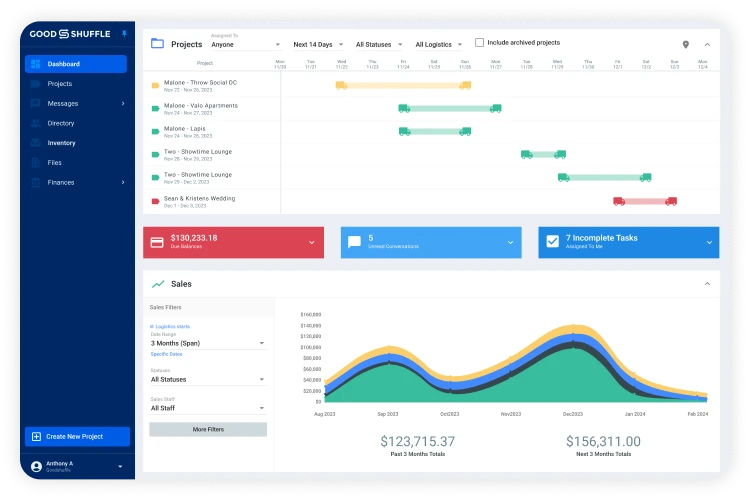We recently partnered with Cam Petty, Founder & CEO of Render Events, on a 3-part series for her podcast about the event business industry.
In addition to leading her own, thriving event rental company, Cam runs one of the top education platforms for event professionals. She’s also a longtime Goodshuffle Pro user who recommends our software to event professionals at all stages of growth.
In Episode Three, she speaks with Mallory Mullen, a Sales Manager at Goodshuffle, about how our software enhances event business marketing. Listen to the podcast by pressing the play button below, or read on for five of the most important takeaways.
1. How to create a cohesive event brand
Cam: Event business marketing can be done through Instagram, Pinterest, YouTube, TikTok, advertisements, podcasts, email marketing…there are so many places it can happen.
All of these channels make up how clients experience your brand.
Think about how your brand comes through your website, the way you email clients, the quotes you send clients, and the post-event processes you do with clients. All of this should look and feel like it’s coming from the same brand. If a client goes from your Instagram to your website, it shouldn’t look like there’s been a huge shift. When they go from your website to receiving a quote from you, it should feel like it’s in line with everything else they’ve seen from your brand.
What I love about Goodshuffle Pro’s event business software is that it marries all this together. When you’re posting something on Instagram, and that same photo is on your website, you can now put that same photo on a quote for your clients to review.
Mallory: You talk about how you have the ability to use photos on social, then have those photos appear on your website, and then they can also appear in your communications with your client or on the quotes and contracts that you send. This breeds confidence and trust in you as a business owner and you as a brand. Your clients believe that you’re consistent and that you’re going to deliver on your promise.
If you’re going to market yourself as a white-glove service, a business that’s easy to work with, then your operations better back that up to deliver on that process. If you have a jazzy Instagram account but you don’t have the operational tools behind you to deliver on that promise, your Google reviews are going to reflect that.
2. Why being transparent makes your brand more valuable
Cam: You can show off who you are as a brand through the photos and descriptions of what you’re charging on a quote. No client loves to pay labor fees, damage waivers, or mileage fees. They sometimes feel like it’s wasted money.
You can combat this notion with marketing. For example, you can add images to these items on quotes. When you include a quality photo of your team next to the line item for labor fees, you’re telling the client, “Here are the joyful, smiling faces that are doing that labor for you.”
Mallory: I love that you’re hitting on this point of transparency. Sometimes, when I have that conversation with business owners, they recoil a little bit, and think, “Gosh, well if I’m transparent, am I sharing my secret sauce? Is my competitor going to suddenly understand everything that’s going into my business?”
What you’re highlighting here is that transparency is such an opportunity for marketing your brand. If you can lean into what the damage waiver is and why you have it, you can accompany this with a photo of your team thoughtfully loading in and caring for items that are being delivered. The client now has confidence that the pieces they order aren’t going to be stained, damaged, or chipped.
Cam: I like to think about it like a bridge of trust. You’re on one side, your client is on the other, and there are substantial things that have to happen for them to trust you. All of these things that we’re doing in marketing are pieces of this bridge that we’re building. It’s not just our phone calls and our email follow-ups to get them to sign the quote. It’s also these little moments in between.
3. Why successful branding requires customization
Cam: With Goodshuffle Pro’s Website Integration, my site doesn’t look like others’ websites. With some other softwares that have a Website Integration or a plugin, you can tell that the vendor is using their tool because it looks the same as everybody else’s who uses that software.
Mallory: We’re giving you the space as a business owner, a brand, as a company, to be flexible to cater to your clients. We don’t want all of our clients to look like they have the same website or the same emails, or have to talk to their clients in all of the same way. The features and functionality that folks like you leverage on a day-to-day basis is where our product really shines. You’ve got this flexibility to get creative and to have that seamless experience.
Cam: Plus, your emails don’t have to look like the blue Goodshuffle Pro brand (though they certainly can if you want them to). There’s an option for you to integrate your logos, your colors, and your voice. You can customize all these things. This goes back to the core of your brand and the way it looks and feels.
Goodshuffle Pro’s email templates are really great for customizing your brand. A lot of people get nervous when you talk about templates because they say, “I don’t want to sound like a robot.” Well, you don’t have to sound like a robot. You can fully edit those templates in Goodshuffle Pro.
Mallory: In the custom email templates that Goodshuffle Pro offers, you can also use the custom email signatures. Cam, I love that your sign-off is “Joyfully, Cam”. You and your team also do a great job of showing photos of your joyful faces! The client really feels that in their communication with you. Even though it’s an email, it’s not 100% written. You’re using photo proof to back up your “joyful” brand.
4. Why customization doesn’t have to be time-consuming
Cam: We find ourselves emailing almost the exact same things every single time we talk to our customers. We’re always sending something about our payment policies, something about how to book, something related to the inventory, or questions we have regarding the timing or layout of the event. A lot of the events we do have the same nuts and bolts that go with the orders. Instead of having to type these emails over and over and over again, we template them! We also add our voice, so it’s clear and on brand.
Mallory: You can also save time when it comes to upselling. A lot of people are used to using Accessories in Goodshuffle Pro to showcase what pieces go well together (for example, a chair and a chair cover). But our Alternates are a good marketing moment on your website for potential clients to explore. Alternates are items that can be swapped in place of each other. So, on your website, you can show a certain sofa, but also a slightly nicer one to capture leads who are willing to pay more for higher quality. And, you do this all without taking your sales team’s time.
Alternates are good reminders to you and your team. You as the business owner can set up Alternates in your Goodshuffle Pro account, and then your sales team can now upsell these Alternates to a client as well. These micro-upsells add up at the end of a contract.
5. How marketing can help drive repeat business
Cam: Within Goodshuffle Pro, I can see all of the events that a client has ever booked with me. We just went through this practice a few weeks ago, where our sales team took all the orders from Q3 and Q4 of last year, and called every single one of the clients to see if they’re rebooking an order for this year or if they’d like to see any quotes for any other events that they’re planning.
Before I even pick up the phone to call the client, I can type in their name or email into Goodshuffle Pro and see all of their past events and the items they rented. Then, when we call them, they feel like they’ve been thought of, instead of having to reach out to us first.
Mallory: Having the tools to be proactive is the key to winning repeat business. I talk to a lot of vendors who want to do these huge marketing campaigns and email blasts and social media campaigns, and all of those things that are important for the bigger brand strategy. But that phone call, and that proactive approach, just saved you a ton of calls, texts, and emails, since you’re no longer relying and waiting on your clients. That’s why people want to come back to do business with you. You’re creating that ease.
Cam: If you look at some of our Google reviews, that’s exactly what our clients are saying: “It’s so easy.” And it’s easy because of Goodshuffle Pro and the Website Integration.
Prior to us having the Website Integration, our clients had to remember what they were seeing on our website, and then put those items into a contact form or an email to us. There wasn’t an easy way for them to add things to their cart and send it our way. In today’s world, everybody utilizes a cart, whether it be Amazon or your favorite clothing shop. Clients everywhere used to doing online shopping. What the Website Integration does is bring this into the events industry.
And, if clients feel like they can trust you, and if they feel like you delivered or over-delivered what they were quoted, then you’re going to have a repeat customer for life.
Click here to learn more about the Render Podcast, including recaps of all past episodes from Cam and the Render team.
Learn More About Goodshuffle Pro
Book a demo to see our event business software in action.







